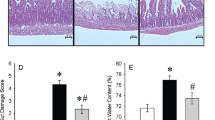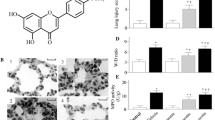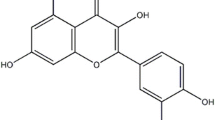Abstract
Treatment with inhaled carbon monoxide (CO) has been shown to ameliorate intestinal injury induced by lipopolysaccharide (LPS) or ischemia-reperfusion in experimental animals. We hypothesized that CO intraperitoneal administration (i.p) might provide similar protection against inhaled gas. In the present study, 1 h after intravenously receiving 5 mg/kg LPS, rats were exposed to either room air or 2 ml/kg of 250 ppm CO i.p for 1, 3, and 6 h. Intestinal tissues were collected to determine the levels of platelet activator factor (PAF), intercellular adhesion molecule-1 (ICAM-1), interlukin-10 (IL-10), maleic dialdehyde (MDA), cell apoptotic rate and the phosphorylated p38 mitogen activated protein kinase (MAPK), as well as myeloperoxidase (MPO) and superoxide dismutase (SOD) activity. After CO i.p, the increase of PAF, ICAM-1, MDA, MPO, and cell apoptosis rate induced by LPS was markedly reduced (P < 0.05 or 0.01), while the decrease of IL-10 and SOD was significantly increased (P < 0.05). Western blotting showed that the effects of CO i.p were mediated by p38 MAPK pathway. Thus, the results of our study show that CO i.p exerts potent protection against LPS induced injury to the intestine via anti-oxidant, anti-inflammation and anti-apoptosis, which may involve the p38 MAPK pathway.









Similar content being viewed by others
References
Arbabi S, Maier RV (2002) Mitogen-activated protein kinases. Crit Care Med 30:s74–s79
Bauer M, Huse K, Settmacher U, Claus RA (2008) The heme oxygenase-carbon monoxide system: regulation and role in stress response and organ failure. Intensive Care Med 34:640–648
Bradbury CM, Markovina S, Wei SJ, Rene LM, Zoberi I, Horikoshi N, Gius D (2001) Indomethacin-induced radiosensitization and inhibition of ionizing radiation-induced NF-kappaB activation in HeLa cells occur via a mechanism involving p38 MAP kinase. Cancer Res 61:7689–7696
Brouard S, Otterbein LE, Anrather J, Tobiasch E, Bach FH, Choi AM, Soares MP (2000) Carbon monoxide generated by heme oxygenase-1 suppresses endothelial cell apoptosis. J Exp Med 192:1015–1026
Craig R, Larkin A, Mingo AM, Thuerauf DJ, Andrews C, McDonough PM, Glembotski CC (2000) p38 MAPK and NF-κB collaborate to induce interleukin-6 gene expression and release. J Biol Chem 275:23814–23824
De Backer O, Elinck E, Blanckaert B, Leybaert L, Motterlini R, Lefebvre RA (2009) Water-soluble CO-releasing molecules reduce the development of postoperative ileus via modulation of MAPK/HO-1 signalling and reduction of oxidative stress. Gut 58:347–356
Delaney CP, Weese JL, Hyman NH, Bauer J, Techner L, Gabriel K, Du W, Schmidt WK, Wallin BA (2005) Phase III trial of alvimopan, a novel, peripherally acting, mu opioid antagonist, for postoperative ileum after major abdominal surgery. Dis Colon Rectum 48:1114–1127
Dolinay T, Szilasi M, Liu M, Choi AM (2004) Inhaled carbon monoxide confers antiinflammatory effects against ventilator-induced lung injury. Am J Respir Crit Care Med 170:613–620
Gibbon SJ, Farrugia G, Haga M (2004) The role of carbon monoxide in the gastrointestinal tract. J Physiol 556(Pt 2):325–336
Goebel U, Siepe M, Mecklenburg A, Stein P, Roesslein M, Schwer CI, Cchmidt R, Doenst T, Geiger KK, Pahl HL, Schlensak C, Loop T (2008) Carbon monoxide inhalation reduces pulmonary inflammatory response during cardiopulmonary bypass in pigs. Anesthesiology 108:1025–1036
Katada K, Bihari A, Mizuguchi S, Yoshida N, Yoshikawa T, Fraser DD, Potter RF, Cepinskas G (2009) Carbon monoxide liberated from CO-releasing molecule (CORM-2) attenuates ischemia/reperfusion-induced inflammation in the small intestine. Inflammation 33(2):92–100
Kohmoto J, Nakao A, Stolz DB, Kaizu T, Tsung A, Ikeda A, Shimizu H, Takahashi T, Tomigama K, Sugimoto R, Choi AM, Billian TR, Murase N, McCurry KR (2007) Carbon monoxide protects rat lung transplants from ischemia-reperfusion injury via a mechanism involving p38 MAP kinase pathway. Am J Transplant 7:2279–2290
Liu DM, Sun BW, Sun ZW, ** Q, Sun Y, Chen X (2008) Suppression of inflammatory cytokine production and oxidative stress by CO-releasing molecules-liberated CO in the small intestine of thermally injured mice. Acta Pharmacol Sin 29:838–846
Liu SH, Xu XR, Ma K, Xu B (2007) Protection of carbon monoxide inhalation on lipopolysaccharide induced multiple organ injury in rats. Chin Med Sci J 22:169–176
Moore BA, Overhaus M, Whitcomb J, Ifedigbo E, Choi AM, Otterbein LE, Bauer AJ (2005) Brief inhalation of low-dose carbon monoxide protects rodents and swine from postoperative ileus. Crit Care Med 33:1317–1326
Moore EE (1998) Mesenteric lympth: the critical bridge between dysfunctional gut and multiple organ failure. Shock 10:407–416
Moore ET, Otterbein LE, Turler A, Choi AM, Bauer AJ (2003) Inhalation carbon monoxide suppresses the development of postoperative ileus in the murine small intestine. Gastroenterology 124:377–391
Morisaki H, Katayama T, Kotake Y, Ito M, Tamatani T, Sakamoto S, Ishimura Y, Takeda J, Suematsu M (2001) Roles of carbon monoxide in leukocyte and platelet dynamics in rat mesenteric during sevoflurane anesthesia. Anesthesiology 95:192–199
Morisaki H, Katayama T, Kotake Y, Ito M, Handa M, Ikeda Y, Takeda J, Suematsu M (2002) Carbon monoxide modulates endotoxin-induced microvascular leukocyte adhesion through platelet-dependent mechanisms. Anesthesiology 97:701–709
Nakao A, Kimizuka K, Stolz DB, Neto JS, Kaizu T, Choi AM, Uchiyama T, Zuckerbraun BS, Nalesnik MA, Otterbein LE, Murase N (2003) Carbon monoxide inhalation protects rat intestinal grafts from ischemia/reperfusion injury. Am J Pathol 163:1587–1598
Nakao A, Schmidt J, Harada T, Tsung A, Stoffels B, Cruz RJ, Kohmoto J, Peng X, Tomiyama K, Murase N, Bauer AJ, Fink MP (2006a) A single intraperitoneal dose of carbon monoxide-saturated ringer's lactate solution ameliorates postoperative ileus in mice. J Pharmacol Exp Ther 319:1265–1275
Nakao A, Toyokawa H, Tsung A, Nalesnik MA, Stolz DB, Kohmoto J, Ikeda A, Tomiyama K, Harada T, Takahashi T, Yang R, Fink MP, Morita K, Choi AM, Murase N (2006b) Ex vivo application of carbon monoxide in University of Wisconsin solution to prevent intestinal cold ischemia/reperfusion injury. Am J Transplant 6:2243–2255
Nieuwenhuijzen GA, Goris RJ (1999) The gut: the ‘motor’ of multiple organ dysfunction syndrome? Curr Opin Clin Nutr Metab Care 2:399–404
Otterbein LE, Bach FH, Alam J, Soares M, Tao LH, Wysk M, Davis RJ, Flavell RA, Choi AM (2000) Carbon monoxide has anti-inflammatory effects involving the mitogen-activated protein kinase pathway. Nat Med 6:422–428
Otterbein LE, Otterbein SL, Ifedigbo E, Liu F, Morse DE, Fearns C, Ulevitch RJ, Knickelbein R, Flavell RA, Choi AM (2003) MKK3 mitogen-activated protein kinase pathway mediates carbon monoxide-induced protection against oxidant-induced lung injury. Am J Pathol 163:2555–2563
Ryter SW, Choi AM (2007) Cytoprotective and anti-inflammatory actions of carbon monoxide in organ injury and sepsis models. Novartis Found Symp 280:165–181
Song R, Kubo M, Morse D, Zhou Z, Zhang X, Dauber JH, Fabisiak J, Alber SM, Watkins SC, Zuckerbraun BS, Otterbein LE, Ning W, Oury TD, Lee PJ, McCurry KR, Choi AM (2003) Carbon monoxide induced cytoprotection in rat orthotopic lung transplantation via anti-inflammatory and anti-apoptotic effects. Am J Pathol 163:231–242
Sun BW, ** Q, Sun Y, Sun ZW, Chen X, Chen ZY, Cepinskas G (2007) Carbon liberated from CO-releasing molecules attenuates leukocyte infiltration in the small intestine of thermally injury mice. World J Gastroenterol 13:6183–6190
Wagener FADTG, Volk HD, Willuis D, Abraham NG, Soares MP (2003) Different face of the heme-heme oxygenase system in inflammation. Pharmacol Res 55:551–571
Wang X, Wang Y, Kim HP, Nakahira K, Ryter SW, Choi AM (2007) Carbon monoxide protects against hyperoxia-induced endothelial cell apoptosis by inhibiting reactive oxygen species formation. J Biol Chem 282:1718–1732
Wang Y, Wu TR, Cai S, Welte T, Chin YE (2000) Stat1 as a component of tumor necrosis factor alpha receptor 1-TRADD signaling complex to inhibit NF-κB activation. Mol Cell Biol 20:4505–4512
Wolff BG, Michelassi F, Gerkin TM, Techner L, Gabriel K, Du W, Wallin BA (2004) Alvimopan, a novel, peripherally acting mu opioid antagonist: results of a multicenter, randomized, double-blind, placebo-controlled, phase III trial of major abdominal surgery and postoperative ileus. Ann Surg 240:728–735
Zabalgoitia M, Colston JT, Reddy SV, Holt JW, Regan RF, Stec DE, Rimoldi JM, Valente AJ, Chandrasekar B (2007) Carbon monoxide donors or heme oxygenase-1 overexpression blocks interleukin-18-mediated NF-kappaB-PTEN-dependent human cardiac endothelial cell death. Free Radic Biol Med 44:284–298
Zevin S, Saunders S, Gourlay SG, Jacob P, Benowitz NL (2001) Cardiovascular effects of carbon monoxide and cigarette smoking. J Am Coll Cardiol 38:1633–1638
Zhang X, Shan P, Alam J, Davis RJ, Flavell RA, Lee PJ (2003a) Carbon monoxide modulates Fas/Fas ligand, caspases, and Bcl-2 family proteins via the p38 mitogen activated protein kinase pathway during ischemia-reperfusion lung injury. J Biol Chem 278:22061–22070
Zhang X, Shan P, Otterbein LE, Alam J, Flavell RA, Davis RJ, Choi AM, Lee PJ (2003b) Carbon monoxide inhibition of apoptosis during ischemia-reperfusion lung injury is dependent on the p38 mitogen-activated protein kinase pathway and involves caspase 3. J Biol Chem 278:1248–1258
Zhang X, Shan P, Alam J, Fu XY, Lee PJ (2005) Carbon monoxide differentially modulates STAT1 and STAT3 and inhibits apoptosis via a phosphatidylinositol 3-kinase/Akt and p38 kinase-dependent STAT3 pathway during anoxid-reoxygenation injury. J Biol Chem 280:8714–8721
Zuckerbraun BS, McCloskey CA, Gallo D, Liu F, Ifedigbo E, Otterbein LE, Billiar TR (2005) Carbon monoxide prevents multiple organ injury in a model of hemorrhagic shock and resusciation. Shock 23:527–532
Acknowledgments
This work is supported by the grants from the Natural Science Foundation of Jiangsu Province (No. 98029) and the Scientific Development Foundation of Jiangsu Province (No. 2000409). We thank Professor LI Chun-Sheng for assistance with the experiments, Professor XU Jian-Guo for valuable discussions, and Dr ZHANG **ao-Liang for statistical analyses.
Author information
Authors and Affiliations
Corresponding author
Additional information
This work was supported by grants from the Natural Science Foundation of Jiangsu Province (No. 98029) and Scientific Development Foundation of Jiangsu Province (No. 2000409).
No conflicts of interest (including financial and other relationships) for each author
Rights and permissions
About this article
Cite this article
Liu, SH., Ma, K., Xu, XR. et al. A single dose of carbon monoxide intraperitoneal administration protects rat intestine from injury induced by lipopolysaccharide. Cell Stress and Chaperones 15, 717–727 (2010). https://doi.org/10.1007/s12192-010-0183-0
Received:
Revised:
Accepted:
Published:
Issue Date:
DOI: https://doi.org/10.1007/s12192-010-0183-0




